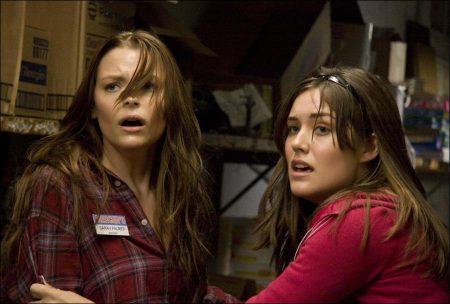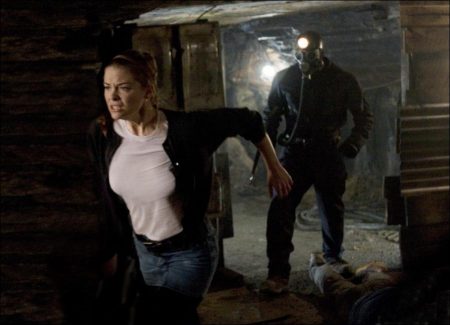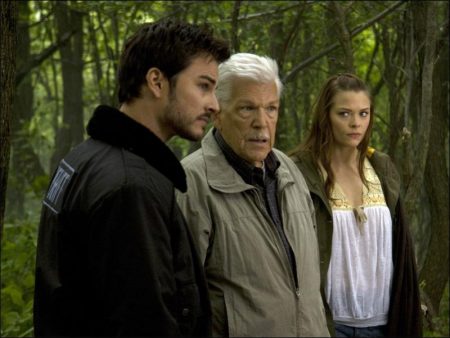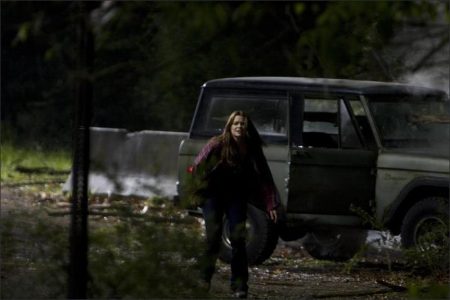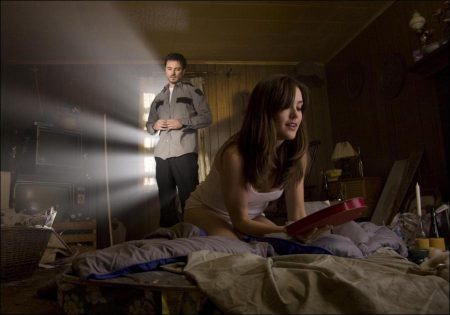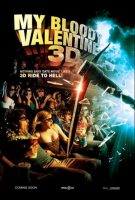My Bloody Valentine 3D movie storyline. A long buried nightmare returns to haunt a small town when one of horror’s most terrifying tales comes to life in a way it has never been seen before. A reimagining of the 1981 film which Quentin Tarantino called “the best slasher movie of all time,” My Bloody Valentine 3D uses the latest dazzling stereographic technology to put audiences in the middle of an unprecedentedly chilling nightmare.
Ten years ago, a tragedy changed the town of Harmony forever. Tom Hanniger, an inexperienced coal miner, caused an accident in the tunnels that trapped and killed five men and sent the only survivor, Harry Warden, into a permanent coma. Then, exactly one year later, on Valentine’s Day, Harry Warden woke up…and brutally murdered twenty-two people with a pickaxe before being killed.
Ten years later, Tom Hanniger returns to Harmony on Valentine’s Day, still haunted by the deaths he caused. Struggling to make amends with his past, he grapples with unresolved feelings for his ex-girlfriend Sarah, who is now married to his best friend Axel, the town sheriff. But tonight, after years of peace, something from Harmony’s dark past has returned. Wearing a miner’s mask and armed with a pickaxe, an unstoppable killer is on the loose. And as his footsteps come ever closer, Tom, Sarah and Axel realize in terror it just might be Harry Warden who’s come back to claim them.
My Bloody Valentine is a 1981 Canadian slasher film directed by George Mihalka and written by John Beaird, starring Paul Kelman, Lori Hallier, and Neil Affleck. Released during the height of the popularity of the slasher genre of the late 1970s and early 1980s, it is considered an example of the horror slashers reminiscent of popular slasher films such as Halloween (1978) and Friday the 13th (1980). It was shot on location in Sydney Mines, Nova Scotia, Canada. Upon its release on February 1981, the film received mixed reviews.
About the Production
In 1981, the slasher film craze was at its peak, driven by the box office success of films such as Halloween and The Last House on the Left. Then, out of placecountry-regionCanada came the controversial low-budget sleeper My Bloody Valentine, whose enormous cult following shocked even its creators. Now, MY BLOODY VALENTINE 3D brings the fear factor to a new level with an immersive and utterly terrifying remake of the ultimate campfire story.
“This is the marriage of old school horror mixed with a great story and unbelievable new technology,” says director Patrick Lussier. “There’s also some good old-fashioned gore. It’s the intersection of so many different things. We’re doing a 3-D movie; we’re doing a slasher film, but it’s much more than that. It requires a new way of looking at storytelling, and it’s a very exciting opportunity.”
“When I first experienced 3-D, it was a gimmick,” producer Jack Murray adds. “It got people in the seats because they’d never seen it before. But it wasn’t about storytelling. It was a carnival trick, just a series of opportunities to set up the next moment where something would come out into the audience. That’s not what we’re doing in this film. We’re letting the 3-D fill out the environment we’re working in, and, at the same time, finding those moments where that third dimension makes it even scarier.”
Michael Paseornek, president of Lionsgate and executive producer of MY BLOODY VALENTINE 3D, elaborates: “Our film uses traditional techniques with very few special effects, plus dimensional space to place viewers’ attention where the director wants it. It immerses the audience in the environment, as opposed to just throwing effects at them. When you’re thinking about creating an environment of tension, if you’re in it-as opposed to watching it-it’s much scarier. Even down to the fact that when someone shines a flashlight around, it blinds you. And when the Miner swings his pickaxe at you, it swipes across you.”
When it came time to select a director for a state-of-the-art update of this blood-soaked classic, the producers found a filmmaker with just the pedigree they were looking for. Lussier, the editor of films including Scream, Dracula 2000 and New Nightmare, is a long time collaborator with legendary horror auteur Wes Craven.
“Patrick’s vision was very much tied to using 3-D to do what it does really well,” says Murray. “There are times where 3-D needs to be right out there grabbing you, but there also need to be moments when the audience gets to relax and just enjoy the story. Along with other techniques and devices like prosthetics, stunts and visual effects, it lets the audience viscerally feel and experience the terror.”
“I can’t imagine working with anyone other than Patrick on this picture,” the producer continues. “He was always on the move, with more ideas than anyone I know. If we had production challenges, Patrick could turn on a dime. And his editing experience allowed him to see what the film was going to look like and know just what he needed from each scene.”
“Plus, he’s got a great sense of humor,” adds Paseornek. “There was a vibe on the set like we were at the right place at the right time with the right people. You can’t buy that kind of synergy. You can’t hire it. It just happens. To sit back and be awash in it is the best.”
Lussier found the prospect of revamping such a beloved film both daunting and rewarding. “The film is a Canadian icon,” says the director, who himself hails from north of the 49th parallel. “The offer to be involved in the project took me by surprise. I really wasn’t sure I wanted to tackle it, but as I read the script and started working with it, I saw the opportunity to bring something new to the story.
“The film is about this great love triangle,” he continues. “What else would you expect from a movie that has `Valentine’ in the title? But the love triangle has gone slightly awry-and as a result has gotten bloody.”
For Lussier, the use of 3-D photography was an intrinsic part of the storytelling. “The feeling of claustrophobia, the feeling of being trapped and the feeling of the horror are all heightened to a point that will take audiences beyond what they have seen before,” he says.
Years of working with horror master Craven taught Lussier that, in order to create a compelling horror movie, character has to come first. “All of Wes’ movies are character-based,” says the director. “If you let the characters and story come first, then the horror comes out of the events, as opposed to concentrating on how much blood you can splash on the screen.”
Actor Kerr Smith, who plays Axel, the sheriff of Harmony, appreciated the director’s commitment to surpassing the usual limitations of the horror genre. “We go to movies to feel things that we may not normally experience. People don’t get that scared that often, but it can be fun. To have that added element of really caring about the people makes it a much better film.”
“There’s nothing more tragic than losing somebody who’s close to you,” Lussier observes. “If I can get the audience as close to the characters as possible, then when absolutely unspeakable events happen, they are on the edge of their seats. And the 3-D makes them feel even more like they’re part of the story. It envelops them, so they’re not just watching it as a spectator sitting in the front row, they are participating in the horror.”
None of this would have been possible without the groundbreaking technology and techniques created by Paradise FX, some of which were developed especially for MY BLOODY VALENTINE 3D. “Once we knew we wanted to make the movie 3-D, we were fortunate enough to find placeParadise,” says Lussier. “Our stereographer Max Penner allowed us to do things that many 3-D filmmakers said couldn’t be done. We were constantly able to push the envelope because we had real pioneers in the realm of 3-D on our side.”
“Our cameras were being finished the day before we started photography,” he recalls. “Everything was manufactured specifically for MY BLOODY VALENTINE 3D and our camera operator, Howard Smith, invented much of the equipment.”
The commitment and creativity of the team made it possible for the filmmakers to exceed expectations of what 3-D can do, according to Lussier. “We were incredibly lucky to have a group of people dedicated to making it the best film possible. They were dedicated to making the best 3-D film ever, something so powerful and unique the audience will be screaming through every curve in the ride.”
Jensen Ackles, who plays Tom, says there’s one moment he is looking forward to seeing in the theater. “The moment the Miner’s pickaxe first comes right out of the screen is going to be awesome,” says the actor. “I’m going to be just as much of an audience member as everybody else, and I’ll be thrilled to see it.”
Kerr Smith adds: “I love scary. And Harry Warden is one of the most frightening film villains of all time. Let’s just say you better love to be scared.”
MY BLOODY VALENTINE 3D takes filmmaking into a new realm, according to Lussier. “We have gone beyond what audiences have seen before, even in CG films. This is totally different because there’s always an artificial quality to that, and this is the actual real events. You are there and part of the story. It has an interactive quality unlike anything you’ve ever seen.”
The Heart of My Bloody Valentine 3-D: Sarah, Tom and Axel
Front and center in MY BLOODY VALENTINE 3D’s story are three high school classmates caught in a decade-old love triangle: Tom, Axel and Sarah-Axel’s wife and Tom’s former high school sweetheart. Jensen Ackles, Kerr Smith and Jaime King, who portray the three primary characters, lead an impressive ensemble cast that combines some of the hottest young Hollywood up-and-comers with acclaimed veteran actors.
“Jensen and Jaime and Kerr bring so much depth to the characters,” says Lussier. “And then we have a great supporting cast with people like Kevin Tighe, Tom Atkins and Edi Gathegi. Every one of them has brought so much more than what was on the page.”
Jensen Ackles plays Tom Hanniger, the catalyst for the story. “Tom is returning to this small town to face some unfinished business,” says Lussier. “Jensen has such a natural charm. He has real cinematic grace and weight to him, which makes Tom incredibly likable and endearing in the face of adversity.”
The unique technical aspects of the film appealed to Ackles’ curiosity. “I think everything’s so much cooler in 3-D,” says the actor, who has seen his share of horror on the long-running television series “Supernatural.” “I’m very interested to see how this story unfolds in that kind of a format. I think it’s really going to increase the scare factor.”
“Patrick was fantastic,” Ackles says of his director. “I believe that editors make very good directors, because they can envision exactly what they want and they know how to get it. Patrick also knows how to work with actors. With that combination, it’s just so easy to work with him.”
Jaime King plays Sarah, the woman at the heart of the film’s romantic triangle. “Jaime is not your typical slasher film chick,” says Lussier. “She brings such depth to the character of Sarah. She plays the conflict of the unrequited love she has for Tom, and balances it with her love for her husband in every moment of her performance.”
King loved Lussier’s character-oriented approach. “All the choices in the script were very thoughtful and extremely layered. Jensen and Kerr and I were able to take the time to sit together and talk about how we could make our story as complex and intricate as possible. It’s really easy to do something that’s very cookie cutter, but I’m not interested in doing that and the people making this movie weren’t either.”
The actress also drew energy and inspiration from her costars, Ackles and Smith. “It’s a great benefit to be on the set with such talented actors,” she says. “Working with Kerr and Jensen gave me a look at their process as actors. Each actor has his own way of bringing something to life and making it real and true for them, and I just really enjoy the experience of collaborating and seeing how we as artists can make the best story possible.”
Kerr Smith, who played most of his scenes with King, is equally effusive about the film’s leading lady. “Jaime’s fantastic,” he says. “It’s always great when you work with somebody who just gets it, and she does. She just understands what each scene is about, so we can explore the most interesting directions to go while we’re doing it.”
The director found the character of Axel the most difficult to cast. “Axel is a very conflicted man with dark tendencies,” he says. “He knows that he was Sarah’s second choice. Kerr’s choices in playing the character are so unique and so deep, and the moments that he draws on and the surprises that he brings to his performance are fascinating.”
“I’m the kind of guy that likes to get in there with no ideas set in stone,” says Kerr. “I have maybe a couple points I want to hit, but essentially what this is all about for me is exploring it while you’re doing it, and finding the truth in the situation. Patrick allowed me a lot of freedom, which was great.”
The ensemble exceeded all the director’s expectations. “They delivered such strong, powerful performances,” says Lussier. “It was extraordinary to have an amazing crew and an incredible cast that continued to surprise each other as part of a massive and wonderful conspiracy to make this incredibly horrific event. Their collaboration has added tenfold to the story because they have truly made these characters as three-dimensional as the film itself.”
The Strange World of My Bloody Valentine
The filmmakers started their search for locations in Pittsburgh, near the heart of western Pennsylvania’s coal mining country. “One of the first locations we locked into was the mine,” says Lussier. “It was no longer a working mine, but it had an amazing, beautiful look.”
“Brutal” is the word Patrick Lussier uses to describe the long production days on MY BLOODY VALENTINE 3D, which gave the cast and crew just a hint of life in a coal mine. “The mine is an incredibly confined space and it’s dripping wet. We were always covered in mud or anything else you can imagine. Every single person on the crew, some of whom have been working in films for 20 or 30 years, said it was the worst place they had ever shot. And yet, they did an amazing job. We were incredibly lucky to have this group of people dedicated to this project.”
The ceiling of the mineshaft in which many of the film’s critical scenes were shot was so low, it was often difficult for the cast and crew to stand up. “It allowed us to create this absolutely claustrophobic world our characters were trapped in for a vital part of the story,” according to Lussier. “The mine had its own sound. You felt it breathing, dripping, crying. You felt trapped inside and could feel the horror as the walls converged.”
placeParadise provided the filmmakers with specially designed rigs for shooting in the mine. “They allowed us to shoot aerially,” says Paseornek. “In the past, that was impossible, because the rig itself was almost 500 pounds.”
The result is that the coal mine has an unprecedented sense of length and depth. “It is not just a dark hole,” Penner explains. “3-D helps you feel like you’re looking into the mine. You feel like you’re moving forward into that mine.”
For the actors, the location was a mixed blessing; difficult to work in, but inspiring. “We got to feel what it is to live in a mining town,” says King. “We were in a mine with little baby bats chillin’ with us. You had to be careful not to knock your head on the ceiling. But I think that if you can be in a real location, it’s awesome. It was definitely helpful in connecting to the character.”
placeStateTexas native Ackles says he was a little out of his comfort zone in the mine. “When you walk in a hundred, or maybe two hundred feet under the earth, and the only way out is way behind you, it’s kind of creepy,” he says.
Says Kerr Smith, “The worst part about working in a mine is that you’re working in a mine. I hit my head a lot, let’s put it that way. But shooting on location is always better, in my book anyway. On a soundstage, you’ve got fake rock. It doesn’t smell like a mine, it doesn’t feel like a mine. This allowed us to really be in the moment a hundred percent.”
And what would a mine be without a Miner? For anyone who has seen the original film, the terror invoked by this sinister, shadowy figure is unforgettable. Who or what is behind the Miner’s mask?
“The mystery is one of the most exciting things about the film,” says Lussier. “There’s somebody committing horrific acts and we don’t know who it is. We don’t know why he’s doing it. The Miner is a ruthless and relentless stalker. He’s the ultimate killing machine. You cannot plead with it. You cannot beg for mercy. It only wants you dead.
“That is what makes this movie terrifying,” the director continues. “It has scenes you’ll never forget. You will laugh one minute and leap out of your seat the next because you are so shocked and surprised by the things that happen.”
“The Miner is not necessarily supernatural. He’s just a guy with an attitude,” smiles placeCityMurray. “And this guy’s attitude is pretty extreme. He’s completely unfeeling, at least as far as anyone can tell. So there’s something absolutely chilling the moment he shows up. And he could be any one of us.”
Covered from head to toe in mining gear, the killer presents an imposing picture. “The reason the Miner is so scary is that he is a machine that does not care anything about you,” says Lussier. “You cannot read anything in his eyes. You cannot see any soul inside. “We changed the costume very little from what it was in the original film,” he continues. “We looked at all sorts of different gas mask designs; we looked at all sorts of miner clothing designs. Ultimately, we realized the original was right. We updated it just a little, so it’s more edgy and worn.”
The Miner’s weapon of choice is a pickaxe, a standard tool in mines because of its versatility of use. “It makes a very, brutal weapon that the Miner wields with rage and accuracy,” says Lussier. “It has a chisel end that is good for ripping pieces of bone apart. It has a spike that you literally can rip off jaws with. You can gouge eyes out. You can rip someone open from stem to stern. There’s no end of useful, wonderful things it can do.”
The man responsible for putting the “bloody” in MY BLOODY VALENTINE 3D is Gary Tunnicliffe. A lifelong fan of horror movies and special makeup effects, Tunnicliffe began developing his craft at Pinewood Studios in London for Image Animation. “I read scripts where it said `then he gets stabbed’ or `his head is chopped off,’” he recalls. “And I always thought there had to be something more interesting we could do there. I just love to sit in a darkened theater watching a movie I’ve worked on, to wait for that `kill’ and then to hear the air sucked out of a room or see the girls — and the guys too — hiding behind their hands. I think it’s the cinematic version of the magician’s `prestige.’ ”
“The film was an incredible opportunity to work on a re-imagined classic `80s horror movie with this iconic killer and push it to new limits.”
Tunnicliffe realized that makeup, no matter how realistic, was not going to cover every angle needed. “The joy of this film is that it’s in 3-D so you see everything.” he says. “With makeup, you only have a couple of inches of depth. We ended up taking casts of the actors and creating a sort of puppet to use as the body. Then the actor could actually put his hand inside when he removed the heart.”
If Patrick Lussier and the rest of the cast and crew had one goal, it was to do justice to the legend that inspired their film. “You know, there was only one My Bloody Valentine,” he says. “They never did a sequel. When it came out, it became notorious for being savaged by the MPAA. There are supposedly nine minutes of mythical cuts to the film that have been removed because of the horror and gore. We have done our absolute best to live up to those nine minutes.”
Valentine’s Bleeding Edge 3D Technology
MY BLOODY VALENTINE 3D was shot in fully optimized 3-D using the new HD 4K format, which can record 4,000 pixel images at 30 frames per second, as opposed to the 2,000 pixels used by standard HD. The filmmakers used two state-of the-art digital cameras: the Red One and the Silicon Imaging SI-2K Digital Cinema Camera. Both are far smaller and lighter than conventional 2-D or 3-D cameras and more intuitive to operate.
The equipment and techniques used on the shoot were revolutionary even for veteran 3-D stereographer Max Penner. “Earlier 3-D cameras had much bigger motors and were much more cumbersome to use,” says the film’s stereographer.
Another difference is that the new equipment uses neither tape nor film. Instead, digital images are stored on compact flash cards and later downloaded to a computer hard drive. The filmmakers were at the forefront of this cutting-edge technology, which Penner says created an on-set rhythm reminiscent of a 35mm film shoot. “It’s not like a tape that’s running for hours. You have to load the camera in four or eight-minute intervals. That familiar workflow puts the crew at ease.”
One of the biggest benefits of the new digital format was it allowed live on-set playback of dailies in 3-D, providing far greater creative control of the image. “In the past, we wouldn’t see how anything looked in 3D until a month after shooting,” Penner says. “On this project, what we were seeing on the monitor was what the audience was going to get in the theater.
“All the 3-D you see in the film was done on the set,” Penner continues. “We were able to dimensionalize the picture on the set in the same manner a focus puller makes his mark or a camera operator composes his schedule. The technology enabled us to look at the situation and judge what we needed right then and there.”
All 3-D photography creates a three-dimensional illusion by recording a pair of 2-D images with two cameras or lenses set slightly apart. By providing each of the viewer’s eyes with a slightly different image of the same scene, 3-D produces an illusion of depth and volume.
“With the new cameras, we were able to adjust the distance between the two lenses, or interaxial convergence point, automatically,” says Penner. “You can’t shoot with parallel cameras and move or change focus length without adjusting the interaxial. That’s what caused a lot of eyestrain in older 3-D movies.
“So if we’re going from opening shot where we see whole room to a close up on someone’s face, we might start out at two inches and end up at a half-inch, gradually decreasing the interaxial spacing as we move in. We were able to automate and repeat that move the same way every time, which gave us the ability control the 3-D camera settings with much more accuracy and consistency.”
Dimensions of Horror: A 3D History
The horror film has long played a leading role in the evolution of 3-D cinema. The visceral nature of the genre and the format’s immersive effects go together like, well, slashers and scream queens. In fact, the first big hit of the “Golden Age” of 3-D was the classic chiller House of Wax (1953), starring Vincent Price. Audiences were captivated by the film’s stereoscopic visuals and Price’s performance in a role that would make him virtually synonymous with the genre.
Many of the most successful films of the first 3-D boom were, if not outright horror, jolting genre exercises such as Bwana Devil (1952), It Came from Outer Space (1953), The Mad Magician (1954) and Alfred Hitchcock’s Dial M for Murder (1954).
Perhaps the most significant of this crop of 3-D fright-fests was The Creature from the Black Lagoon (1954), the story of a team of archaeologists menaced by a prehistoric half-man, half-fish. Creature’s use of 3-D cinematography was limited but memorable. It spawned two sequels and its iconic Gill Man character rightfully took its place among the ranks of Universal’s famed monsters.
For various technical and financial reasons, Hollywood’s first 3-D craze was brief, but horror kept the format’s flame lit over ensuing decades in low-budget independent films. In 1961, a Canadian B-movie called The Mask chilled placecountry-regionU.S. audiences with its eerie hallucinatory sequences shot in 3-D. Andy Warhol’s Frankenstein (1973) combined 3-D horror with another popular genre of the `70s: softcore porn.
In the early 1980s, three-dimensional bogeymen stalked mainstream cinemas once again. Friday the 13th Part III (1982) was loaded with innovative 3D imagery hailed for “going past the lens”-an effect in which objects appear to thrust from the screen into the theater. The slasher sequel nearly doubled the box office of the franchise’s previous installment and paved the way for major studio releases Jaws 3-D and Amityville 3-D the following year.
Due to the high costs and lingering technological challenges associated with the format, 3-D once again fell out of favor with studios and theater owners in the mid1980s. 3-D cinema was largely relegated to IMAX documentaries for most of the next 20 years. Gradually, however, the obstacles limiting widespread 3-D exhibition in the United States have been overcome. Today, the format is more attractive than ever before to the industry, artists and audiences.
Innovations in camera technology have reduced the cost of shooting in 3D and allow filmmakers to create more exciting visual effects. And audiences are no longer subjected to the old headache and eyestrain-inducing red and blue (“anaglyph”) glasses. The predominant 3-D formats today, Real D and Dolby 3D Digital Cinema, use polarized glasses that are comfortable and provide crystal clear images.
3-D presentations of films such as Polar Express (2004), Chicken Little (2005), Beowulf (2007) and Journey to the Center of the Earth (2008) have dramatically outperformed their “flat” screenings. In 2009 alone, no fewer than nine animated 3-D films are scheduled for theatrical release. Major franchises such as Shrek, Cars, Kung Fu Panda and Toy Story will make the leap to 3-D in their next installments.
Given the format’s recent successes and promising new technologies on the horizon, the combination of 3-D and horror is likely to keep audiences on the edge of their seats for years to come.
My Bloody Valentine 3D (2009)
Directed by: Patrick Lussier
Starring: Jaime King, Jensen Ackles, Kerr Smith, Edi Gathegi, Kevin Tighe, Megan Boone, Betsey Rue, Marc Macaulay, Karen Baum, Liam Rhodes, Selene Luna, Cherie McClain, Denise Dal Vera
Screenplay by: Todd Farmer, Zane Smith
Production Design by: Zack Grobler
Cinematography by: Brian Pearson
Film Editing by: Cynthia Ludwig, Patrick Lussier
Costume Design by: Leeann Radeka
Set Decoration by: Maurin L. Scarlata
Art Direction by: Andrew Murdock
Music by: Michael Wandmacher
MPAA Rating: R graphic, brutal horror violence and grizzly images throughout, strong sexuality, graphic nudity and language.
Distributed by: Lionsgate Films
Release Date: January 16, 2009
Views: 107
